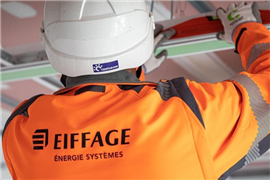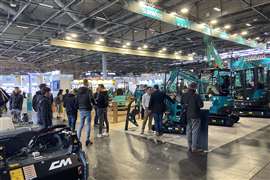Up by the sea
25 April 2008

The role of dockside cranes is clearly defined- they must load and unload ships as quickly as possible, they must work constantly all day every day and require as little maintenance as possible. The role becomes even more demanding when looking at the growth of the international shipping industry.
Intercargo, the International Association of Dry Cargo Shipowners, claims that the international shipping industry is responsible for handling 90% of world trade.
It is difficult to convert this to a monetary figure, as figures for trade estimates are traditionally in terms of tonne-miles. The tonne-mile figure is calculated by multiplying the number of tonnes carried by the distance travelled. In 2003, for example, the industry shipped around 6.1 thousand million tonnes over a distance of 4 million miles, giving more than 25 thousand billion tonne-miles of total trade. For ports and cargo handling companies, this means an increasing, and lucrative, workload.
Throughout the last century the shipping industry saw a general trend of increases in total trade volume. Increasing industrialisation and the liberalisation of national economies fuelled free trade and a growing demand for consumer products. Advances in technology have also made shipping an increasingly efficient and swift method of transportation. Over the last four decades total seaborne trade estimates have nearly quadrupled, from less than 6 thousand billion tonne-miles in 1965 to an estimated 30 thousand billion tonne- miles by the end of 2006.
In 2005, the world trading fleet was made up of 46,222 container and other cargo ships, with a combined tonnage of 597,709,000 tonnes.
The United Nations Conference on Trade and Development (UNCTAD) estimated in 2005 that the operation of merchant ships contributes about US$380 billion in freight rates in the global economy, equivalent to about 5% of total world trade.
Such large increases in the volume of shipping means that there are significantly more containers to load and unload. The latest technology and gadgets, such as personal MP3 players and DVDs, are mostly shipped around the world from the Far East. The cost of export by sea equates to $1.50 for a DVD player that retails for $200, so it is easy to see why the ocean is the route of choice for exporters.
Users of dockside cranes (ports) face stiff competition from each other to secure business, and more often than not it is quicker and more economical to add to existing cranage, either in volume or lifting capacity, than expand the actual size of a port.
Asia Pacific
The Asia Pacific region is one of the world's biggest buyers of construction cranes, and is showing a great appetite for dockside machines.
India is cited by Liebherr as one of the region's main buyers as the country develops and modernises its ports.
Bothra Shipping Services bought two new LHM 400 units in four rope configuration for use at its bulk handling terminal in Visakhapatnam, on the south coast. Both cranes have a pair of 70 tonne capacity winches and four-rope grabs optimise handling of bulk cargoes up to 70 tonnes.
Other Indian buyers of LHMs include Seaport Shipping (one unit) and Gautam Freight Pvt. Ltd (two units). The cranes will be put to work for Seaport Shipping at Vizag Seaport (southern India) and for Gautam at Kandla on the Eastern coast.
All three cranes have two 70 tonne winches to give handling rates of up to 1,500 tonnes per hour. Seaport Shipping asked for the inclusion of Liebherr's Cycoptronic anti-sway control system as well as an economy software for optimised fuel consumption.
Kranbau Eberswalde has also noted a rise in customers in the region. The company has sold container and harbour cranes to several Vietnamese ports over the last 12 months. The company's global sales of dockside cranes have recently reached a total of 4,600 units.
P&O Ports Australia has ordered six Kalmar all- electric E-One rubber-tyred-gantry (RTG) cranes - three 8+1 wide and 1-over-5 high units for its Port Botany Container Terminal in Sydney and three 6+1 wide and 1-over-5 high for its Fremantle Terminal on the west coast. The RTGs are scheduled for delivery in third quarter 2006.
P&O Ports handles approximately 50% of all containers loaded and unloaded in Australia and provides multi-purpose stevedoring and related materials handling services at more 30 ports around the country. To handle these volumes, the company relies heavily on a large fleet of RTGs, 20 of which are in service at the Port Botany Container Terminal in Sydney and nine of which are at the Fremantle Container and RoRo Terminal. The E-One order was placed as part of P&O Ports' replacement programme for its RTG fleet.
In New Zealand, Christchurch-based Lyttelton Port Company has bought a new post Panamax size Liebherr container crane to work alongside a similar crane that has been owned since 1992 at the Port of Wellington.
The new crane has a 46 m waterside outreach and rail span of 19 m. Landside backreach is 14 m and lift height under spreader 34 m. The crane's safe working load is 60 tonnes.
Also in New Zealand, CentrePort (Port of Wellington), has ordered two new post Panamax container cranes. The cranes will have 43 m waterside outreach and rail span of 22.86 m. Landside backreach is 14.20 m and lift height under spreader is 32 m. Safe working load is 50 tonnes in twinlift operation and 55 tonnes under hookbeam.
One in every port
South African Ports Operation (SAPO) has ordered 25 straddle carriers from Kalmar to work at the Port of Durban.
More than 60% of container traffic to and from South Africa goes through Durban, making it the busiest port on the African continent. At present, Port of Durban handles approximately 1.8 million TEU (tonne equivalent unit) and is aiming for a capacity of 2.4 million TEU by 2007. To achieve this target SAPO is renewing its container handling equipment and will standardise its fleet to Kalmar equipment. The current order is a follow up to an August 2005 order for 53 straddle carriers.
SAPO has also ordered 14 Liebherr Super Post Panamax container cranes for the Ports of Durban and Cape Town.
All 14 cranes have an operational outreach of 52 m and can operate on the latest Super Post Panamax size container vessels. They have expandable twin-lift telescopic spreaders allowing the handling of 20, 40, 2 x 20 and 45 foot containers. Height under spreader is 37 m.
In Germany, The Port of Hamburg's biggest container terminal operator, Hamburger Hafen und Logistik AG (HHLA), has ordered a Kalmar automatic stacking crane (ASC) system and related technology for the first step in the conversion of its Container Terminal Burchardkai facility to a semi-automated operation. In phase one of the terminal conversion, Kalmar will equip the first five yard stacking blocks with 15 ASCs, along with their automation and control systems, during 2007 and 2008. The first cranes will arrive at Burchardkai at the beginning of 2007.
The Burchardkai terminal handled about 2.7 million TEU last year. HHLA aims to increase its capacity to 5.2 million TEU by re-engineering the operation and converting the main part of the conventional straddle carrier container storage area to an ASC system by the year 2015. HHLA also aims to significantly improve productivity. During the conversion process all present terminal operations must be able to continue uninterrupted, while capacity increases gradually.
By 2015 Container Terminal Burchardkai will be operated as a 'block' system, with 30 yard blocks stacking ten containers wide, five high and 44 TEU (330 m) long. Each block will employ two smaller ASCs capable of straddling the ten-wide, five-high blocks and one wider and higher ASC, capable of passing over the smaller machines with a loaded container. Operating on separate sets of rail tracks, the cranes will be able to move freely in the block.
From the quayside, containers will be transported by straddle carriers to a buffer area, where they will be collected by the ASCs. Outgoing containers will also be handled through the buffer area using the same system.
On the landward side of the block, the ASCs will either load and unload road trucks, operated through a remote control system by terminal control room staff, or handle containers automatically in a straddle carrier buffer lane.
The contract includes an option for an additional 75 ASCs.
The first buyer of Gottwald's new E AGV (Automatic Guided Vehicle) is HHLA's Container Terminal Altenwerder (CTA) in the Port of Hamburg, Germany, with an order of 11 machines.
The new diesel-electric E AGVs can carry one 20- 45 foot container or two 20 foot containers. Maximum loading weights are 40 tonnes for a single container or 60 tonnes for two 20 foot containers. A robotic vehicle will automatically refuel the cranes.
Both axles are steered independently, which, Gottwald claims, ensures excellent manoeuvrability. However, compared to the existing AGVs, the E AGV's axles are no longer driven hydraulically, but by electric motors.
UK terminal operator, Tilbury Container Services (TCS) awarded Kalmar a contract for the refurbishment of 13 straddle carriers. This project comes on top of an existing contract where Kalmar is carrying out routine servicing of the entire TCS straddle carrier fleet. TCS operates 39 straddles at Tilbury.
Under the refurbishment programme, each of the 13 straddles were assessed and major repairs identified, prioritised and actioned according to need. This process, according to Kalmar, provides better value for money than simply renovating each machine according to set guidelines.
The Bulgarian Port of Varna became Gottwald Port Technology's first customer in the country with the purchase of a 100 tonne capacity HMK 300 E mobile harbour crane. Located in the eastern part of the country on the Black Sea coast, Varna is a fast-growing economic centre for Bulgaria and the Black Sea region.
The Americas
Brazilian port services company Serra Morena chose a new Liebherr LHM 320 G mobile harbour crane to work at Porto Novo, in the Port of Rio Grande, Rio Grande do Sul. Designed for heavy bulk handling, the crane has two 70 tonne capacity winches and a 26 m2 grab.
A Liebherr bulk handling crane has been purchased by grain handling company Fortesolo for its operations at Paranagua, Brazil.
Fortesolo's new LHM 250 has a 38 m outreach, a lifting capacity of 64 tonnes and a four-rope grab with 20 m2 capacity. The new unit will be delivered in June.
Another Brazilian grain handling company, Aduvos Trevo SA, based in Porto Alegre, chose a special Liebherr ship crane application for terminal operations, a CBW 21-30/20 fixed cargo crane. The unit, which Liebherr claims offers a “highly cost- efficient cargo handling solution to river terminals and small sea terminals for the loading and unloading of containers, bulk and general cargoes,” will be used to unload fertilizer.
Brazilian terminal operator Tecondi has ordered two post-panamax LHM 500 HD harbour mobile cranes. The cranes have a 5 m tower extension and a special lifting capacity upgrade package allowing them to handle fully laden containers up to the 17th row of post-panamax vessels, making them the largest ever Liebherr harbour mobile cranes to be supplied to the Americas. In addition the cranes have been fitted with an electric drive as an alternative to the diesel engine power supply.
Tecondi operates a 100,000 m2 container terminal in the port of Santos, located near the Santos business district and the main rail and road connections to the port.
In Colombia, Sociedad Portuaria Regional de Barranquilla has ordered a new Liebherr LHM 250 to work alongside two Liebherr LHM 1300s it bought previously. The new crane has a 25 m2 grab and a second operator's cabin to give a better view of the load.
Colombian banana producer Banacol has bought a Liebherr LRS 645 reachstacker, the first in South America. The wheeled machine with telescopic boom will mainly load and unload river barges as well as for yard operations at Banacol's facility in the Colombian Port of Turbo. Since introduction in 2004, more than 20 LRS 645s have been delivered to various European customers with other orders coming in from customers in Asia, Africa and now Latin America.
The new crane, which was handed over in May, will be used as a container handling crane at the port.
St James Stevedoring, one of the leading bulk handling companies on the Lower Mississippi River in the US, is the first buyer of Gottwald's HPK Harbour Pontoon Crane (barge crane in the US).
It has been christened Alex G after Alex Goldberger, owner of St James Stevedoring.
St Petersburg-based Petrolesport became Liebherr Container Cranes Ltd's first Russian customer after ordering four RTG cranes.
The RTG's have 16 wheel configuration, stack one over five containers high and span six containers plus a truck lane.
To cope with new business secured in October 2005 that will boost its container throughput by some 500,000 TEU a year, the Port Authority of Jamaica (PAJ) has ordered 24 4-high Kalmar CSC 450 straddle carriers and six 7-high Kalmar empty container handlers for its facility at Kingston Container Terminal.
The additional throughput will exceed the 1.5 million TEU terminal capacity but because land expansion is unfeasible in a short time frame, PAJ decided that the best solution would be additional stacking density. This will be achieved by the use of 4-high straddle carriers to increase the average stacking height of loaded containers and empty container handlers to block-stow empties and clear an additional footprint for loaded boxes.
The first units were handed over in April 2006, with delivery completion scheduled for July 2006. The order will bring the total number of straddle carriers in operation at Kingston to 74.
Kingston operates through two terminals - the Port Bustamante North Terminal and the Gordon Cay South Terminal. The facility first passed the 1 million TEU throughput mark in 2002 and has been averaging 10% annual growth.






